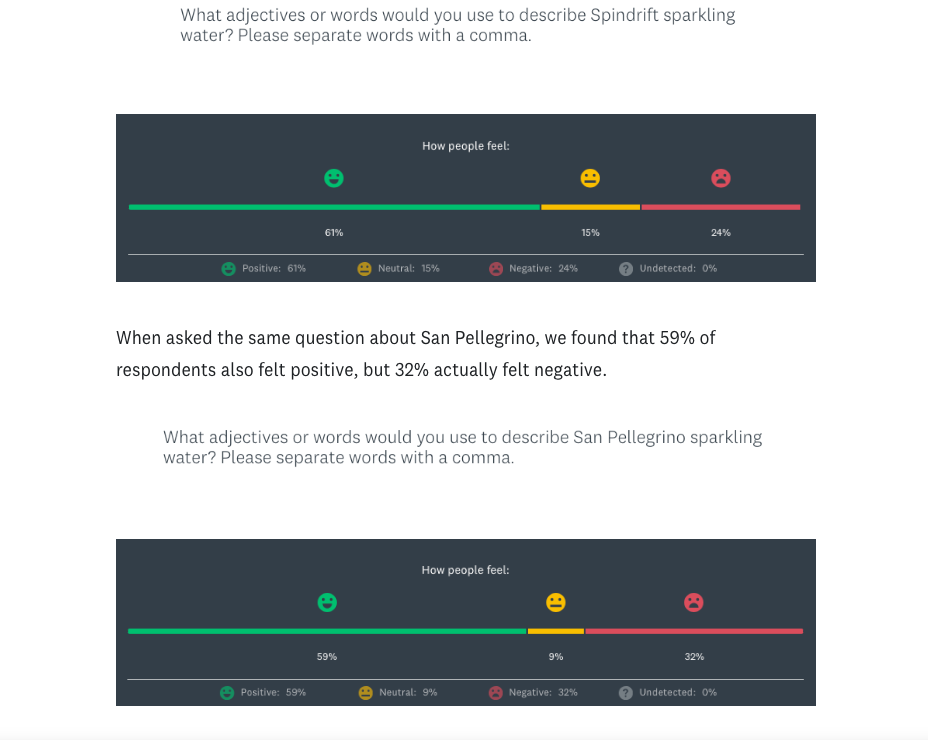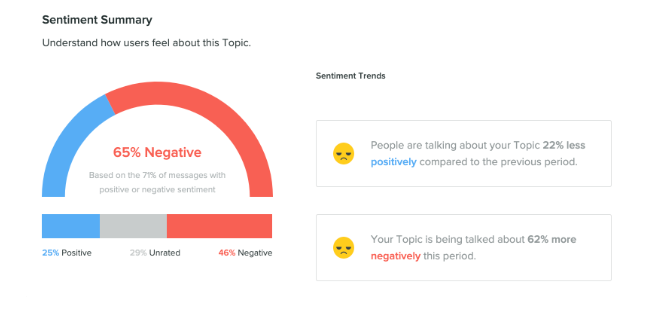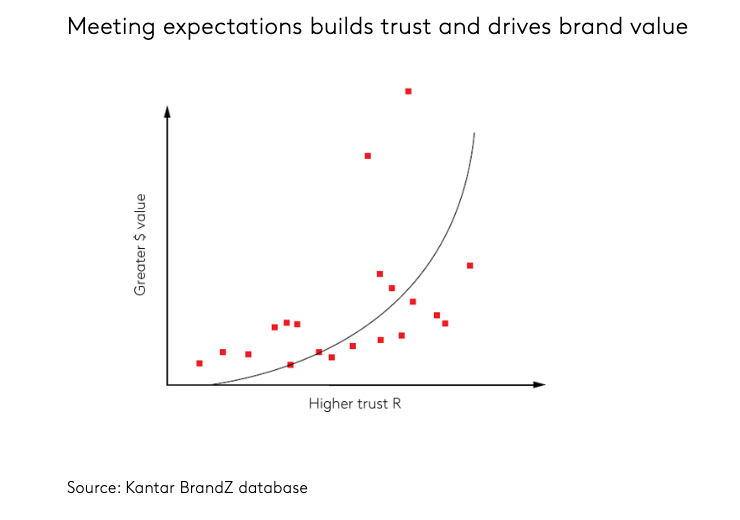Strategy
How to Track User Sentiment vs. User Behavior in Your Content
Customers take action for a reason. You’re probably used to making strategic decisions to motivate them to perform a certain action. But if you don’t also know why they’re taking that action, you don’t have the whole picture.
Customer behaviors only indicate what’s already happened. For example, you know, at some point, someone put an item in their cart but didn’t buy it.
When you have a pulse on what customers are feeling or their general sentiment, you can predict more accurately what will happen in the future — like guessing a certain product might flop. We’ll look at how to measure sentiment using examples from brands with successful programs.
What Is Sentiment?
Customer sentiment measures how people feel about you — specifically your brand, products, or marketing campaigns. Sentiment adds depth to your awareness measurement strategy by shedding light on why your audience might feel a certain way about you (positive or negative).
A sentiment analysis can lead to strategic marketing decisions that greatly benefit a company’s bottom line.
Take Old Spice, for example. They needed to refresh the feeling that their brand was just for older men and wanted to attract more millennials. They successfully changed sentiment towards their brand with celebrity partnerships and a very effective advertising strategy.
Every action a person takes on your website has a reason behind it, whether it’s a click, engaged page view, form fill, or purchase.
Sentiment allows you to understand why people take action.
Why Marketers Should Measure Sentiment
It’s not enough for people to know about a brand anymore. They’re much more likely to purchase if they feel emotionally connected to you. That’s why you need to know how to measure sentiment. It’s one way to measure that emotional connection and craft a story around data you’re already collecting.
For example, say traffic to one of your webinar landing pages is much higher than usual, dropping your conversion rate. It turns out the company you partnered with recently got some negative press, and that news outlet linked to your webinar page. Your conversion rate can be explained as a consequence of that negative press.
They can also help predict when future activities might not go as planned. Let’s say you plan to attend an industry event next year. Part of your presence there will be the launch of a series of NFTs for sale. Then, as the event approaches, sentiment around NFTs drops, just in time for your team to pivot to another incentive.
How to Measure Sentiment
The best way to measure sentiment is with direct feedback from your customers or audience, but you can also keep a pulse on conversations in public spaces. Let’s look at how to measure sentiment with examples from brands already doing it well.
1. Support Ticket Analysis and Customer Calls
If you have a system where customers can call you directly or submit a ticket to a support team, natural language processing (NLP) tools can help you analyze sentiment based on those customer calls.
Based on the specific phrasing your customers use, NLP determines whether or not the conversation was positive or negative and crunches that data at scale. NLP tools can even take it one step further and automatically take action to improve sentiment.
Puneet Mehta, founder and CEO of Netomi, has seen firsthand NLP and artificial intelligence’s (AI) ability to give detailed information about customers to agents in their call center in real time. It even suggests the most appropriate agent for each scenario.
When customers ask complex questions, the AI summarizes and routes tickets to the right agent based on experience, bandwidth, sentiment, and other factors. Not only does their NLP tool help measure sentiment, but it’s actively working to improve it with a more positive customer support experience.
2. Company and Product Reviews
The most valuable part of an online review is the written text. Just like conversations in a call center, you can measure their sentiment using NLP technology.
The British Airways Holidays team uses NLP technology to analyze review sentiment regularly. This allows them to understand their campaigns’ impact on sentiment and ensure they’re optimizing for activities to drive the largest revenue.
Before adopting an NLP tool, they analyzed reviews by manually exporting them and labeling each with topics like ease, quality, trust, or location. This may be a good solution if adopting a new tool isn’t in the cards. Plus, reading reviews yourself may allow you to connect the dots that technology wouldn’t. This is especially true for reviews that might include sarcasm or slang, which is harder for NLP tools to identify.
Whether you choose a tool or a manual solution, regularly analyzing review sentiment can be a powerful indicator of customer emotions.
3. Survey Your Database of Customers and Contacts
Reach out directly to your contact or customer list with a sentiment survey. You can quickly learn how customers feel about you with a few multiple-choice questions and a Google form.
SurveyMonkey used its own tool for research on the sparkling water industry. They asked respondents how they perceived sparkling water brands like La Croix, Spindrift, San Pellegrino, and Schweppes by asking what adjectives they would use to describe them.
They then analyzed sentiment to determine whether those words were positive or negative. Words like “refreshing,” “bubbly,” and “tasty” were considered positive, whereas words like “dry,” “unpleasant,” and “mediocre” were considered negative.
They found that 61 percent of respondents felt positive about Spindrift, while only 24 percent felt negative about the brand. On the other hand, 59 percent of respondents felt positive about San Pellegrino, but 32 percent actually felt negative.
With information like this, Spindrift might feel more comfortable developing products that directly compete with San Pellegrino or running an ad campaign that directly points out the differences between them and their competitor.
4. Social Listening Tools
Analyzing the conversation about your brand or products on social media platforms is another powerful way to measure sentiment. Tools like Mention or Buzzsumo can help you collect and analyze data about your brand or select relevant topics.
Doctors of the World works to deploy thousands of doctors, nurses, and reporters in areas of need, and part of their mission is to ensure the safety of those people.
They use social listening tools to measure the political and social sentiment in their regions of focus and quickly forward any relevant information to dispatched teams.
From a brand perspective, they measure media attention and how it affects their perception. They also analyze influencer activity to identify endorsements they should leverage and those to keep their distance from.
5. Calculate Your Net Promoter Score
As a result of monitoring sentiment, you might look to calculate your net promoter score (NPS), which quantifies how likely your brand is to be recommended to a friend or colleague. You can calculate NPS as follows:

A high NPS typically indicates positive sentiment. The more customers are willing to promote your brand for you, the better they feel about you.
You can collect data using a customer survey, asking support reps or salespeople to conduct surveys, or prompting website or platform visitors with a quick poll.
6. Brand Study
Working with a third-party measurement company allows you to measure sentiment before and after customers interact with a specific marketing campaign.
Companies like Kantar, Nielsen, and Qualtrics use ad platforms and brands to measure brand awareness, lift, sentiment, engagement, and more. For example, Aviva wanted to know what was specifically driving positive versus negative sentiment with customers, journalists, and the public.
They worked with Kantar’s Voices Tracker to determine how each group talked about the brand in the public domain using a combination of social listening, webscraping, and human analysis before and after specific marketing activities.
Sentiment Reveals the “Why” Behind Your Audience’s Actions
How people “feel” about you at any given time will always be challenging to quantify. The most accurate sentiment measurement strategies will incorporate several tools for a well-rounded view of your impact.
Regardless, regularly analyzing brand sentiment is a powerful way to inform your marketing strategy. Sentiment can help reveal the “why” behind customer actions and empower marketers to tell a strong story behind their awareness data.
Sign up for The Content Strategist newsletter for more insights into how to strengthen your brand using content and measurement strategies like these.
Image by sesameGet better at your job right now.
Read our monthly newsletter to master content marketing. It’s made for marketers, creators, and everyone in between.









